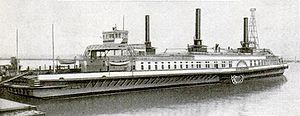Solano (ferry)
The Solano was a large railroad ferryboat which operated across the Carquinez Strait between Benicia and Port Costa in California.
It was constructed and operated by the Central Pacific Railroad to ferry entire trains on the Central Pacific transcontinental line to and from the San Francisco Bay Area. Before its sister ship, the Contra Costa, was constructed, the Solano was the largest ferryboat ever built.
The Solano, named for the county in which Benicia sits, was built in 1878 in Oakland, California. It was 424 feet long and 116 feet wide (129 by 35 m) and was capable of carrying entire passenger trains or a 48-car freight train and locomotive. It was in service from 1879 to 1930.
Its sister ship, the Contra Costa, was built in 1914 and also ran until 1930. It was slightly larger than the Solano, and remains the largest rail ferryboat ever built. The Contra Costa was named for the county in which Port Costa is located.
By 1927, the two ferries reached their maximum capacity. On May 31, 1928 the Southern Pacific, successor to the Central Pacific in operations of the ferries, authorized construction of a railroad bridge from Benicia to Martinez just east of Port Costa. The railroad bridge opened in November 1930. It continues to serve the Union Pacific and Amtrak railroads.
Following the opening of the railroad bridge, the Solano and Contra Costa were dismantled and sold for scrap. However, what remains of the Solano can still be seen where it was scuttled to create a breakwater near Antioch, California. [1] 38°01′01″N 121°48′18″W / 38.01694°N 121.805°W

